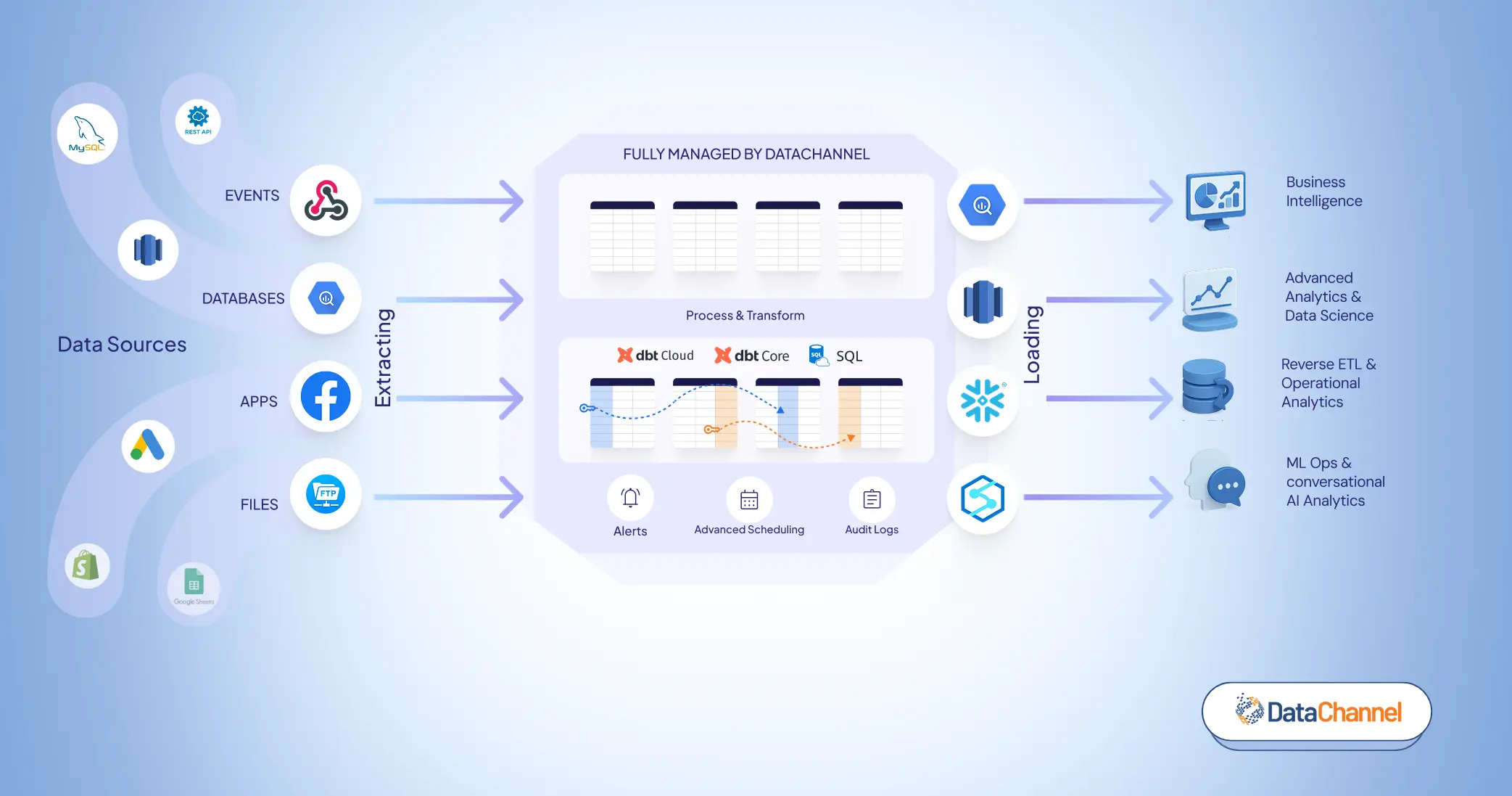
Decoding Data Centralization: History, Need, & Emerging Trends

“Centralized data is the key to leading a data-driven culture” (Source)
Data Centralization has been a prevalent challenge in recent times. Teams are becoming more & more data-abundant and less & less insights-driven. The Reason — Lack of Centralized data hub that leads to increased data accessibility & faster insights.
“Centralized data reduces reporting time by 80-90 percent” (Source)
Data centralization reduces reporting time and there has been an increasing acceptance of building a centralized data repository in the industry. However, a gap remains between centralized data and data integration. These two aspects shouldn’t be mutually exclusive and businesses need to realize the importance of the power of these two working together to unlock the true value of their data.
Data Centralization is the bridge that unites teams across organizations and eliminates the divide between tech and the non-tech teams. No/Low code tools have been on the rise in the past decade so that the marketing teams can make use of the features & capabilities that were earlier only limited to the D&A Teams.
In this article, we’ll be decoding data centralization, giving you a quick ride through evolution of modern data stack & data storage solutions. Down the line we’ll also be talking about the needs, limitations, and emerging trends in data centralization.
Evolution of Data Storage Solutions
In the past, data primarily relied on devices like floppy disks, CDs and hard drives. However, these devices became increasingly susceptible to damage and limited storage capacity. This resulted in the development of server-based storage, where data was housed on-premise in dedicated servers. In the paragraphs below we have briefly discussed the journey of data storage from on-premise to a more centralized cloud one.
1. On-Premise (on-prem) Data Storage:
Traditionally, organizations stored their data on-prem, meaning they maintained physical servers and storage systems within their own facilities. On-premise solutions require significant upfront investments in hardware, infrastructure, and maintenance. Scalability was a big issue with on-prem solutions often limited by physical restrictions, requiring organizations to accurately forecast their storage needs and invest in additional hardware as they grow.
2. The Emergence of Cloud Storage:
Cloud storage solutions offer an alternative to on-premise infrastructure by providing data storage and management services over the internet/ cloud. Cloud providers like Amazon Web Services (AWS)- Redshift, Microsoft Azure, and Google Cloud Platform (GCP)- Big Query, and Snowflake are a few of the most popular cloud data warehouse units. With cloud storage, organizations can easily scale their storage capacity horizontally or vertically based on demand, enabling greater flexibility and cost-efficiency. Cloud providers handle hardware maintenance, access to long-term historical data, and security, freeing up IT resources and reducing administrative overhead.
Different Cloud Data Storage Solutions
Below is a tabular format comparing databases, data warehouses, and data lakes based on various characteristics

Data Lake + Warehouse = Data Lakehouse
A new type of storage solution, i.e., the data lakehouse is also on the rise. Why??
Because companies store their structured data in data warehouses and their unstructured data in data lakes to support efficient analytics and machine learning models. However, maintaining two separate storage systems entails additional administrative and storage costs, potentially compromising data quality and freshness. Hence, the emergence of data lakehouses, an advanced storage solution that combines the capabilities of both a data warehouse and a data lake.

A data lakehouse works on ‘Medallion Architecture’ that usually involves three layers that work together as-
- In the first layer ie., bronze layer, first step of data extraction from different data sources takes place.
- The next layer is the silver layer where preliminary steps that build up to the final transformed data layer takes place
- In the final culminating layer i.e., gold layer, granular level data transformation takes place on which after running suitable johns + aggregates data finally becomes ready for use by data consumers.
Data Lakehouses merge the best aspects of data warehouses and data lakes into one comprehensive data management solution. A data lakehouse seeks to address the limitations of data warehouses by integrating both object-oriented and predefined schema storage functionalities. This capability enables the data lakehouse to store structured data akin to a data warehouse, as well as unstructured or semi-structured data, similar to a data lake.
A data warehouse also follows a similar architecture when it comes to maintaining data flow from an incoming data source. The nomenclature could however be different that of a data lakehouse and more or less revolves around
Raw > Stage > Transformed
Similar to a data lakehouse the data quality inside a data warehouse also improves (into a more or less structured format) as it moves down the different layers, however, unlike a data lakehouse data warehouses work only with third-party integrations.
Importance of Data Centralization
- Enhanced Data Accessibility and Visibility: When you have all your data aggregated, transformed, analysis-ready and stored in one place, stakeholders get to spend less time cleaning the data and more on building the insights that matter. When working with a centralized data hub, teams regardless of their technical background get to work on it unanimously. For example, when the marketing teams have a clear understanding of how and why behind the data they are working on it reduces their dependency on the tech team while also improving their overall performance & decision-making.
- Improved Consistency: Data Centralization also leads to improvement in consistency throughout the organization as everyone gets to work with the same data serving their unique needs. For example, sales and marketing teams can work together coherently in building more streamlined customer journeys when working with the same data. When both the teams have access to all the customer details they get to make more holistic and unified customer journeys while also ensuring better customer experience.
- Better Data Quality: Businesses work with multiple data sources and they constantly struggle with aggregating this scattered data. Data centralization helps in eliminating data silos and substantially increases data quality. With centralized data, every department works in complete uniformity with 360° data visibility to better optimize their business decisions while also being cost-effective.
- Enhanced Data Security and Compliance: Not only data accessibility, quality, and visibility, a centralized version of data also helps with data security & compliance. Here’s how:
- Centralized and role-based data access & control
- Mitigation of risk of compromising on user’s personal & sensitive information
- Centralized data enables an organization to regulate and control data access and interaction at all levels.
- Working with third-party tools (integrations) that follow the much required data governance and compliance protocols.
- Reduced Costs: More data silos also means more administrative and overhead costs. A centralized data center such as a data lake or or a database can help you store both transactional and analytical data in one place, and is far less costly. Generally businesses use a database for storing their transactional data and a data warehouse for their analytical requirements owing to the higher costs associated with the latter.
- Efficient Reporting & Analytics: A centralized source of truth also enables efficient reporting & analytics as both business teams and tools have access to fresh + up-to-date data. Efficient reporting & analytics also enables teams to better forecast and change customer preferences and adapt to them accordingly. WIth trustworthy data points in hand marketing teams can better identify cross/ up selling opportunities and convert a higher number of potential leads into customers.
Challenges and Considerations related to Storage Solutions
On-Prem Data Storage solutions have almost become redundant owing to the high overhead costs and scalability issues. With the emergence of cloud data warehouses a few of the challenges that stakeholders face are related to firstly vendor lock-in. Vendor lock-in risks arise as organizations commit to a specific cloud provider's ecosystem and services, potentially limiting flexibility and increasing long-term overhead costs. Sometimes, migration itself from one cloud provider to another is pretty complicated due to the data compliance and security related issues.
Secondly, dependence on internet connectivity introduces concerns regarding latency and reliability, particularly for critical applications. To address these challenges, many organizations adopt hybrid or multi-cloud strategies. Hybrid solutions enable them to retain sensitive or critical data on-premise while leveraging the scalability and flexibility of the cloud for less sensitive workloads. On the other hand, multi-cloud strategies involve distributing workloads across multiple cloud providers to mitigate vendor lock-in risks and optimize performance, cost, and resilience.
Emerging Trends
After the arrival and evolution of data warehouses, the focus more or less has always been on centralizing data to eliminate data silos from the data stack as much as possible. Distinguished cloud data warehouse solutions such as Google Big Query, Snowflake, Azure Synapse have been the cloud storage partners for many organizations till now. While centralized data storage has been the top most priority for data-driven organizations, what we are witnessing today is a shift from a centralized approach to a decentralized one.
Decentralization in the sense that with the data being generated rapidly with ever evolving businesses’ data needs and requirements, creating a single version of truth becomes challenging. Thus, instead of relying on a central source of truth businesses rely on a more organized or decentralized approach i.e, data residing in data lakes, lake houses, cloud data warehouses, and on-premises (along with non-relational) databases, etc.
This decentralized approach is going to mark a new paradigm shift in the data centralization landscape. The hurdle that persists now is to adopt new technologies and tools that enable businesses to manage data in a much more efficient way while ensuring data governance and security compliance similar to centralized data solutions.
Along with decentralization, one of the most prominent emerging trends relies on Real-time data integration. Unlike traditional/ batch processing that businesses used to rely on for uncovering crucial data insights, there has been a marked increase in real-time data integration. This becomes especially important for eCommerce businesses where customer touchpoints need to be updated on a much more nuanced level to keep up with changing customer preferences. Real-time data integration helps enable real-time analytics while also powering efficient reporting and data backed decision making.
Machine learning and Artificial Intelligence have also become an integral part of businesses today, more and more businesses across the globe have started incorporating ML/AI into their day-to-day operations and activities. ML/AI plays an important role when it comes to forecasting and predictive analytics be it eCommerce, finance, driverless driving, etc. However, these machine learning models need to be trained on reliable historical data without compromising on any user’s private or sensitive information, and that’s where the nitty gritty of secure data integration comes into play.
To learn more about data centralization and how you can unlock unparalleled insights & accessibility, schedule a demo or consider a trial with DataChannel..
Try DataChannel Free for 14 days









